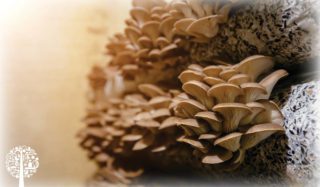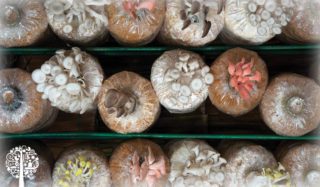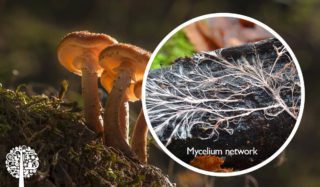Fungi are incapable of photosynthesis and feed on organic matter, forming a kingdom quite distinct from plants. Most fungi are made up of an underground system called mycelium and sporophores and usually emerge from the ground with a stalk and a cap. Apart from truffles and a few other species with underground sporophores, we most often consume the visible parts when eating mushrooms.
Some species of edible mushrooms are easily cultivated; the fall is a great time to grow mushrooms outdoors.
Easy Peasy
Oyster mushrooms and shiitake are arguably the easiest mushrooms to grow. Those with more experience can also try hedgehog hydne, maitake, sulfur polypore, reishi, and wine cap Stropharia. Fungi mycelium can be found on the market in bags, plugs, or a liquid contained in a syringe.
The easiest cultivation method is to place the mycelium outside in a tree-shaded location, shallow in the ground, with a mixture of woodchips, hardwood sawdust, or dead leaves. Then, keep the soil moist by watering it two or three times a week.
Oyster mushrooms and shiitake can also be grown in textile pots. First, place potting soil inoculated with mycelium, supplemented with woodchips or sawdust, all around and against the sides of the container. Then, fill the center of the planter with ordinary potting soil suitable for edible plants. Keep the soil consistently moist. After a few weeks, the fungi will pass through the fabric; no need to make any holes! Fungi may also emerge on the surface of the soil.

These mushrooms can also be grown in a shaded area on logs from freshly cut hardwood trees. Drill holes in the logs and fill them with mycelium plugs. Ideally, cover the holes with beeswax.
White oyster, Blue oyster, and elm oyster mushrooms are perennial fungi whose mycelium survives the harsh winters of northern regions such as Canada and the northern United States.
Less hardy, shiitake – a fungus renowned for its ability to increase the immune system’s strength – overwinter better when its mycelium is inserted into a hardwood tree log or textile pot in the fall, ideally a month before the first frost. Protect “the crop” with a thick blanket of dead leaves and snow.
Mushrooms everywhere!
The largest living organism on the planet is a fungus called Armillaria ostoyae that grows in the soil of the Malheur National Forest in Oregon, US. This fungus’s vast mycelium network covers an estimated area of over 9 square kilometers! It is believed that this fungus is 2,500 years old.
Did You Know?
Botanically speaking, mushrooms are not plants. Instead, they form a separate kingdom, of which approximately 120,000 species have been described so far. However, some scientists estimate that there are probably between 2.2 and 3.8 million species of fungi on Earth, including mushrooms, yeasts, and molds.
Most fungi are made up of, among other things, an underground system called mycelium, which is a tangle of root-like filaments called hyphae. You can find up to 100 kilometers of hyphae in one liter of soil! A single mushroom can produce over a kilometer of mycelium in 24 hours.
Fungi also have structures called sporophores, which are their fruiting bodies or, in other words, their reproductive organs. In many fungi, these sporophores consist of a stalk and a cap with lamellae on which the spores are located.
Fun Mushroom Facts
Fungi are beneficial, if not necessary, for the survival of many plants. In nature, the roots of most plants – over 80% of all species – are closely associated with fungi. The mycelium of different species of fungi acts as an extension of the root system of plants, allowing them to obtain better supplies of water and nutrients. Some plants, such as various orchids, cannot germinate without a fungus. In return, the plants that live alongside these fungi provide them with sugars for their growth and development. This beneficial association between the roots of a plant and a fungus is called mycorrhizae. Of Greco-Latin origin, the word mycorrhiza comprises the terms myco, which means fungus, and rhiza, which means root.

